Feasibility of Urban–Rural Temperature Difference Method in Surface Urban Heat Island Analysis under Non-Uniform Rural Landcover: A Case Study in 34 Major Urban Agglomerations in China
Abstract
1. Introduction
2. Materials and Methods
2.1. Study Area
2.2. Data
2.2.1. MODIS Land Surface Temperature
2.2.2. MODIS Land Cover Type
2.2.3. Elevation
2.3. Quantification of SUHII
3. Results
3.1. Urban Form Expansion
3.2. Comparison of Different SUHII Quantifications
3.2.1. Comparison of Monthly SUHIIs
3.2.2. Comparison of Long-Term Variation in Monthly SUHIIs
3.3. Spatiotemporal Patterns of Regional SUHII in China
3.3.1. Day–Night Cycle
3.3.2. Monthly Variation
3.3.3. Interannual Trend
4. Discussion
5. Conclusions
- (1)
- Among the 34 UAs in China, 32 UAs other than Lanzhou and Lhasa experienced significant urban expansion accompanied by changes in surrounding rural land use types during 2003–2019, underscoring the significance of defining the dynamic urban–rural extent in SUHII quantification.
- (2)
- Considering different SUHII quantifications at each UA, the long-term variation in monthly SUHII and SUHII1/SUHII2 showed identical trends with strong correlation coefficients of over 0.9 in most (32) UAs but with varying magnitudes in certain arid UAs.
- (3)
- The regional patterns of diurnal and monthly SUHIIs revealed by considering the entire rural area, in Northeast, Northwest, and Southeast China, respectively, are not influenced by the diversity of rural land covers.
- (4)
- Seasonal SUHII exhibits disparities in day–night variation and regional contrast in China. In summer, SUHII peaks at noon and decreases at night, exhibiting the opposite pattern in the northwest region. Conversely, in winter, SUHII is lowest at noon and rises at night for most regions, with the southeast region displaying the opposite trend.
- (5)
- The monthly variation in daytime SUHII is more pronounced than that at night. Nationally, daytime SUHII peaks in July (or August) and reaches its lowest point in December (or January), with nighttime values remaining relatively stable across geographical regions.
- (6)
- Interannual trends of SUHII vary across different regions. On a national scale, there is no significant trend in annual daytime SUHII from 2003 to 2019, while nighttime SUHII shows a steady increase at a rate of 0.07 °C/decade. Both summer daytime and nighttime SUHII exhibit significant increasing trends, with rates of 0.11 °C/decade and 0.10 °C/decade, respectively. Notably, there is a significant increasing trend (0.08 °C/decade) for winter nighttime SUHII.
Author Contributions
Funding
Data Availability Statement
Acknowledgments
Conflicts of Interest
References
- Clinton, N.; Gong, P. MODIS detected surface urban heat islands and sinks: Global locations and controls. Remote Sens. Environ. 2013, 134, 294–304. [Google Scholar] [CrossRef]
- Peng, S.; Piao, S.; Ciais, P.; Friedlingstein, P.; Ottle, C.; Bréon, F.-M.; Nan, H.; Zhou, L.; Myneni, R.B. Surface Urban Heat Island Across 419 Global Big Cities. Environ. Sci. Technol. 2012, 46, 696–703. [Google Scholar] [CrossRef] [PubMed]
- Oke, T.R. The energetic basis of the urban heat island. Q. J. R. Meteorol. Soc. 1982, 108, 1–24. [Google Scholar] [CrossRef]
- Zhao, S.; Liu, S.; Zhou, D. Prevalent vegetation growth enhancement in urban environment. Proc. Natl. Acad. Sci. USA 2016, 113, 6313. [Google Scholar] [CrossRef]
- Grimm, N.B.; Faeth, S.H.; Golubiewski, N.E.; Redman, C.L.; Wu, J.; Bai, X.; Briggs, J.M. Global change and the ecology of cities. Science 2008, 319, 756–760. [Google Scholar] [CrossRef] [PubMed]
- Bai, X.; Dawson, R.J.; Ürge-Vorsatz, D.; Delgado, G.C.; Salisu Barau, A.; Dhakal, S.; Dodman, D.; Leonardsen, L.; Masson-Delmotte, V.; Roberts, D.C.; et al. Six research priorities for cities and climate change. Nature 2018, 555, 23–25. [Google Scholar] [CrossRef]
- Patz, J.A.; Campbell-Lendrum, D.; Holloway, T.; Foley, J.A. Impact of regional climate change on human health. Nature 2005, 438, 310–317. [Google Scholar] [CrossRef]
- O’Loughlin, J.; Witmer, F.D.W.; Linke, A.M.; Laing, A.; Gettelman, A.; Dudhia, J. Climate variability and conflict risk in East Africa, 1990–2009. Proc. Natl. Acad. Sci. USA 2012, 109, 18344. [Google Scholar] [CrossRef] [PubMed]
- Kalnay, E.; Cai, M. Impact of urbanization and land-use. Nature 2003, 425, 102. [Google Scholar] [CrossRef]
- Zhou, D.; Xiao, J.; Bonafoni, S.; Berger, C.; Deilami, K.; Zhou, Y.; Frolking, S.; Yao, R.; Qiao, Z.; Sobrino, J.A. Satellite remote sensing of surface urban heat islands: Progress, challenges, and perspectives. Remote Sens. 2019, 11, 48. [Google Scholar] [CrossRef]
- Du, Y.; Xie, Z.Q.; Zhang, L.L.; Wang, N.; Wang, M.; Hu, J.W. Machine-Learning-Assisted Characterization of Regional Heat Islands with a Spatial Extent Larger than the Urban Size. Remote Sens. 2024, 16, 20. [Google Scholar] [CrossRef]
- Li, Z.-L.; Si, M.; Leng, P. A review of remotely sensed surface urban heat islands from the fresh perspective of comparisons among different regions (Invited Review). Prog. Electromagn. Res. C 2020, 102, 31–46. [Google Scholar] [CrossRef]
- Zhou, D.; Zhao, S.; Liu, S.; Zhang, L.; Zhu, C. Surface urban heat island in China’s 32 major cities: Spatial patterns and drivers. Remote Sens. Environ. 2014, 152, 51–61. [Google Scholar] [CrossRef]
- Peng, J.; Jia, J.; Liu, Y.; Li, H.; Wu, J. Seasonal contrast of the dominant factors for spatial distribution of land surface temperature in urban areas. Remote Sens. Environ. 2018, 215, 255–267. [Google Scholar] [CrossRef]
- Zhang, P.; Imhoff, M.L.; Wolfe, R.E.; Bounoua, L. Characterizing urban heat islands of global settlements using MODIS and nighttime lights products. Can. J. Remote Sens. 2010, 36, 185–196. [Google Scholar] [CrossRef]
- Yu, Z.; Yao, Y.; Yang, G.; Wang, X.; Vejre, H. Spatiotemporal patterns and characteristics of remotely sensed region heat islands during the rapid urbanization (1995–2015) of Southern China. Sci. Total Environ. 2019, 674, 242–254. [Google Scholar] [CrossRef] [PubMed]
- Deilami, K.; Kamruzzaman, M.; Liu, Y. Urban heat island effect: A systematic review of spatio-temporal factors, data, methods, and mitigation measures. Int. J. Appl. Earth Obs. Geoinf. 2018, 67, 30–42. [Google Scholar] [CrossRef]
- Zhou, D.; Zhao, S.; Zhang, L.; Sun, G.; Liu, Y. The footprint of urban heat island effect in China. Sci. Rep. 2015, 5, 2–12. [Google Scholar] [CrossRef]
- Chakraborty, T.; Lee, X. A simplified urban-extent algorithm to characterize surface urban heat islands on a global scale and examine vegetation control on their spatiotemporal variability. Int. J. Appl. Earth Obs. Geoinf. 2019, 74, 269–280. [Google Scholar] [CrossRef]
- Si, M.; Li, Z.-L.; Nerry, F.; Tang, B.-H.; Leng, P.; Wu, H.; Zhang, X.; Shang, G. Spatiotemporal pattern and long-term trend of global surface urban heat islands characterized by dynamic urban-extent method and MODIS data. ISPRS J. Photogramm. 2022, 183, 321–335. [Google Scholar] [CrossRef]
- Haashemi, S.; Weng, Q.; Darvishi, A.; Alavipanah, S.K. Seasonal variations of the surface urban heat Island in a semi-arid city. Remote Sens. 2016, 8, 352. [Google Scholar] [CrossRef]
- Patel, S.; Indraganti, M.; Jawarneh, R.N. A comprehensive systematic review: Impact of Land Use/ Land Cover (LULC) on Land Surface Temperatures (LST) and outdoor thermal comfort. Build. Environ. 2024, 249, 13. [Google Scholar] [CrossRef]
- Martin-Vide, J.; Sarricolea, P.; Moreno-García, M.C. On the definition of urban heat island intensity: The “rural” reference. Front. Earth Sci. 2015, 3, 24. [Google Scholar] [CrossRef]
- Zhao, S.; Zhou, D.; Liu, S. Data concurrency is required for estimating urban heat island intensity. Environ. Pollut. 2016, 208, 118–124. [Google Scholar] [CrossRef] [PubMed]
- Song, W.; Deng, X.Z. Land-use/land-cover change and ecosystem service provision in China. Sci. Total Environ. 2017, 576, 705–719. [Google Scholar] [CrossRef] [PubMed]
- Liu, Y.S. Introduction to land use and rural sustainability in China. Land Use Policy 2018, 74, 1–4. [Google Scholar] [CrossRef]
- Yao, R.; Wang, L.; Huang, X.; Liu, Y.; Niu, Z.; Wang, S.; Wang, L. Long-term trends of surface and canopy layer urban heat island intensity in 272 cities in the mainland of China. Sci. Total Environ. 2021, 772, 145607. [Google Scholar] [CrossRef] [PubMed]
- Si, M.; Li, Z.-L.; Tang, B.-H.; Liu, X.; Nerry, F. Spatial heterogeneity of driving factors-induced impacts for global long-term surface urban heat island. Int. J. Remote Sens. 2023, 1–21. [Google Scholar] [CrossRef]
- Zhou, D.; Xiao, J.; Frolking, S.; Zhang, L.; Zhou, G. Urbanization Contributes Little to Global Warming but Substantially Intensifies Local and Regional Land Surface Warming. Earth’s Future 2022, 10, e2021EF002401. [Google Scholar] [CrossRef]
- Zhou, D.; Zhang, L.; Li, D.; Huang, D.; Zhu, C. Climate-vegetation control on the diurnal and seasonal variations of surface urban heat islands in China. Environ. Res. Lett. 2016, 11, 074009. [Google Scholar] [CrossRef]
- Li, X.C.; Liu, S.R.; Ma, Q.W.; Cao, W.T.; Zhang, H.G.; Wang, Z.H. Impacts of spatial explanatory variables on surface urban heat island intensity between urban and suburban regions in China. Int. J. Digit. Earth 2024, 17, 17. [Google Scholar] [CrossRef]
- Fang, J.; Chen, A.; Peng, C.; Zhao, S.; Ci, L. Changes in Forest Biomass Carbon Storage in China between 1949 and 1998. Science 2001, 292, 2320–2322. [Google Scholar] [CrossRef] [PubMed]
- Wu, X.; Wang, G.; Yao, R.; Wang, L.; Yu, D.; Gui, X. Investigating Surface Urban Heat Islands in South America Based on MODIS Data from 2003–2016. Remote Sens. 2019, 11, 1212. [Google Scholar] [CrossRef]
- Simwanda, M.; Ranagalage, M.; Estoque, R.C.; Murayama, Y. Spatial Analysis of Surface Urban Heat Islands in Four Rapidly Growing African Cities. Remote Sens. 2019, 11, 1645. [Google Scholar] [CrossRef]
- Mansourmoghaddam, M.; Rousta, I.; Malamiri, H.G.; Sadeghnejad, M.; Krzyszczak, J.; Ferreira, C.S.S. Modeling and Estimating the Land Surface Temperature (LST) Using Remote Sensing and Machine Learning (Case Study: Yazd, Iran). Remote Sens. 2024, 16, 24. [Google Scholar] [CrossRef]
- Sulla-Menashe, D.; Friedl, M.A. User Guide to Collection 6 MODIS Land Cover (MCD12Q1 and MCD12C1) Product; USGS: Reston, VA, USA, 2018; pp. 1–18. [Google Scholar]
- Rozenfeld, H.D.; Rybski, D.; Andrade, J.S.; Batty, M.; Stanley, H.E.; Makse, H.A. Laws of population growth. Proc. Natl. Acad. Sci. USA 2008, 105, 18702–18707. [Google Scholar] [CrossRef] [PubMed]
- Gao, J.; Huang, X.; Ni, M. Spatio-temporal distribution of heat island effect in Lhasa and its response to land-use/cover in 2012-2016. Meteorological 2018, 44, 936–943. [Google Scholar]
- Wen, L.; Peng, W.; Yang, H.; Wang, H.; Dong, L.; Shang, X. An analysis of land surface temperature (LST) and its influencing factors in summer in western Sichuan Plateau: A case study of Xichang City. Remote Sens. Land Resour. 2017, 29, 207–214. [Google Scholar]
- Xie, M.; Wang, Y.; Fu, M. An Overview and Perspective about Causative Factors of Surface Urban Heat Island Effects. Progress Geogr. 2011, 30, 35–41. [Google Scholar]
- Fernandes, R.; Leblanc, S.G. Parametric (modified least squares) and non-parametric (Theil–Sen) linear regressions for predicting biophysical parameters in the presence of measurement errors. Remote Sens. Environ. 2005, 95, 303–316. [Google Scholar] [CrossRef]
- Mondal, A.; Khare, D.; Kundu, S. Spatial and temporal analysis of rainfall and temperature trend of India. Theor. Appl. Climatol. 2015, 122, 143–158. [Google Scholar] [CrossRef]
- Yang, Q.Q.; Xu, Y.; Wen, D.W.; Hu, T.; Chakraborty, T.; Liu, Y.; Yao, R.; Chen, S.R.; Xiao, C.J.; Yang, J. Satellite Clear-Sky Observations Overestimate Surface Urban Heat Islands in Humid Cities. Geophys. Res. Lett. 2024, 51, 10. [Google Scholar] [CrossRef]
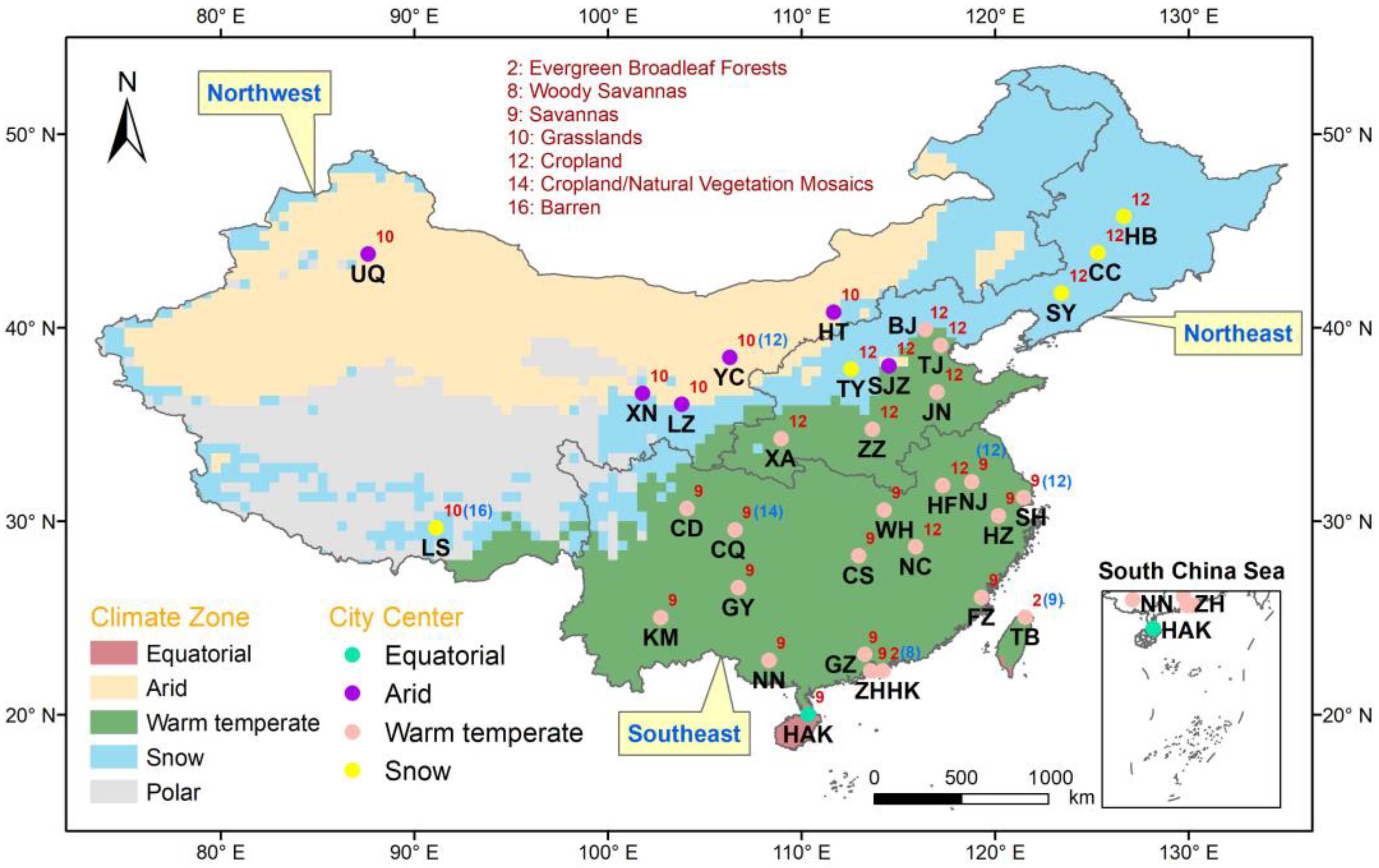

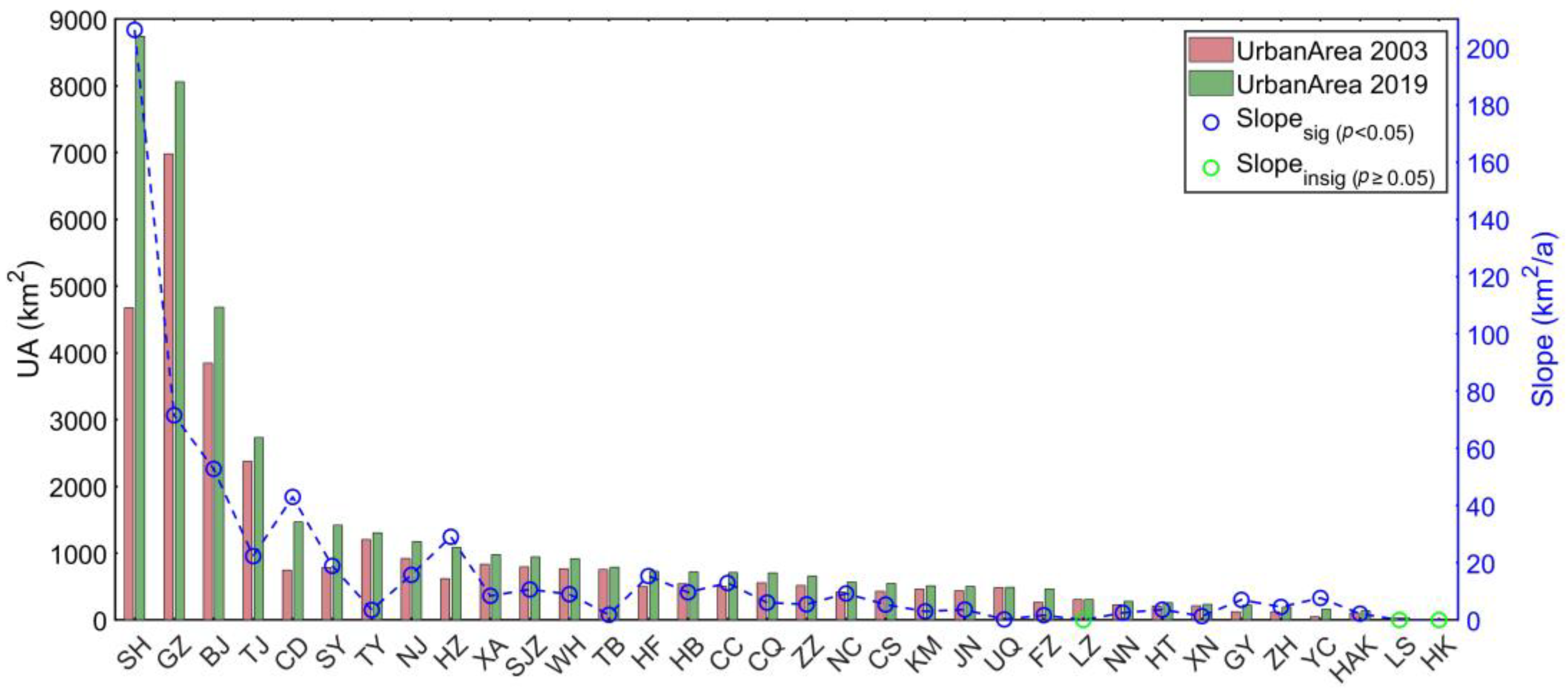


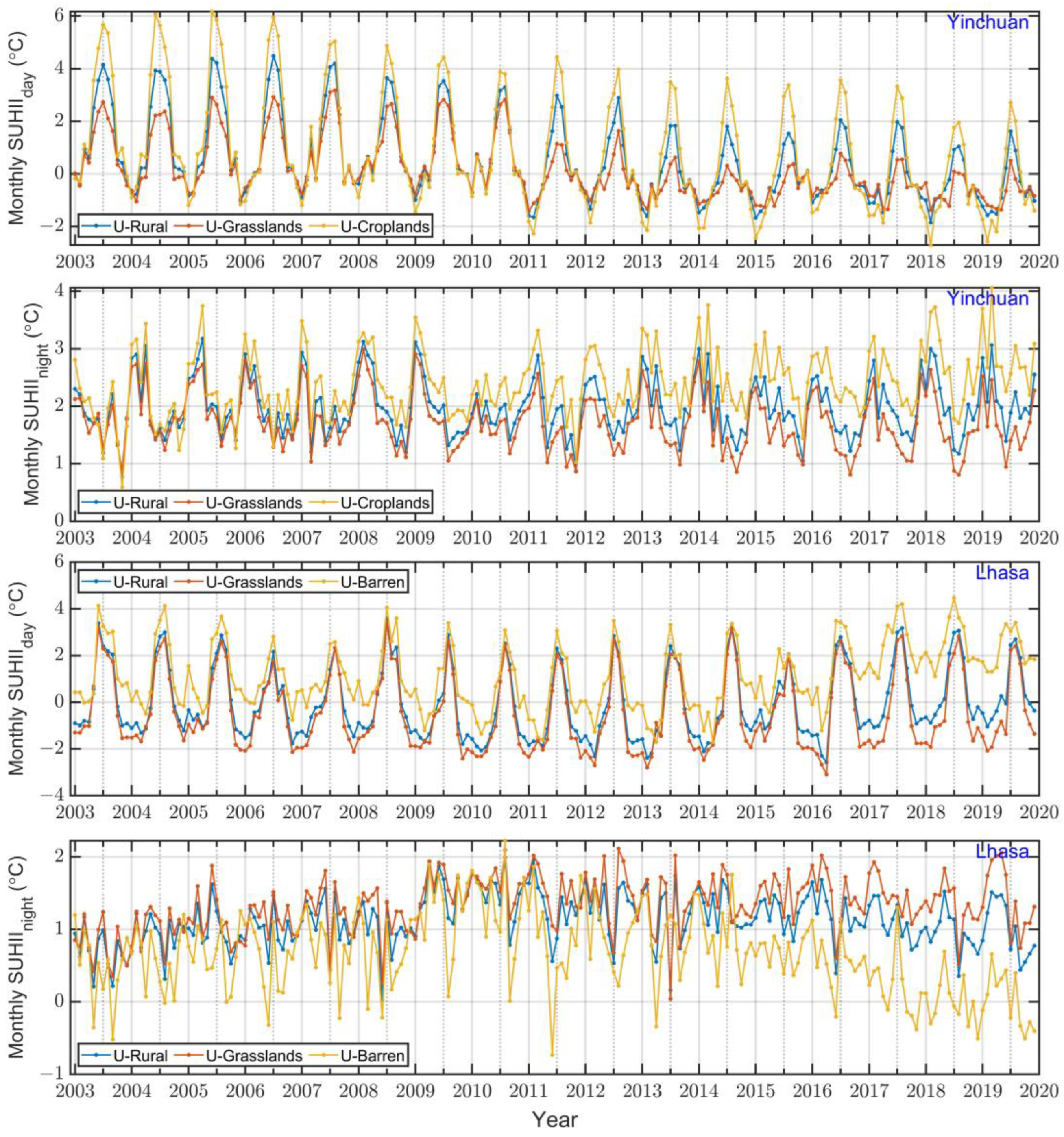


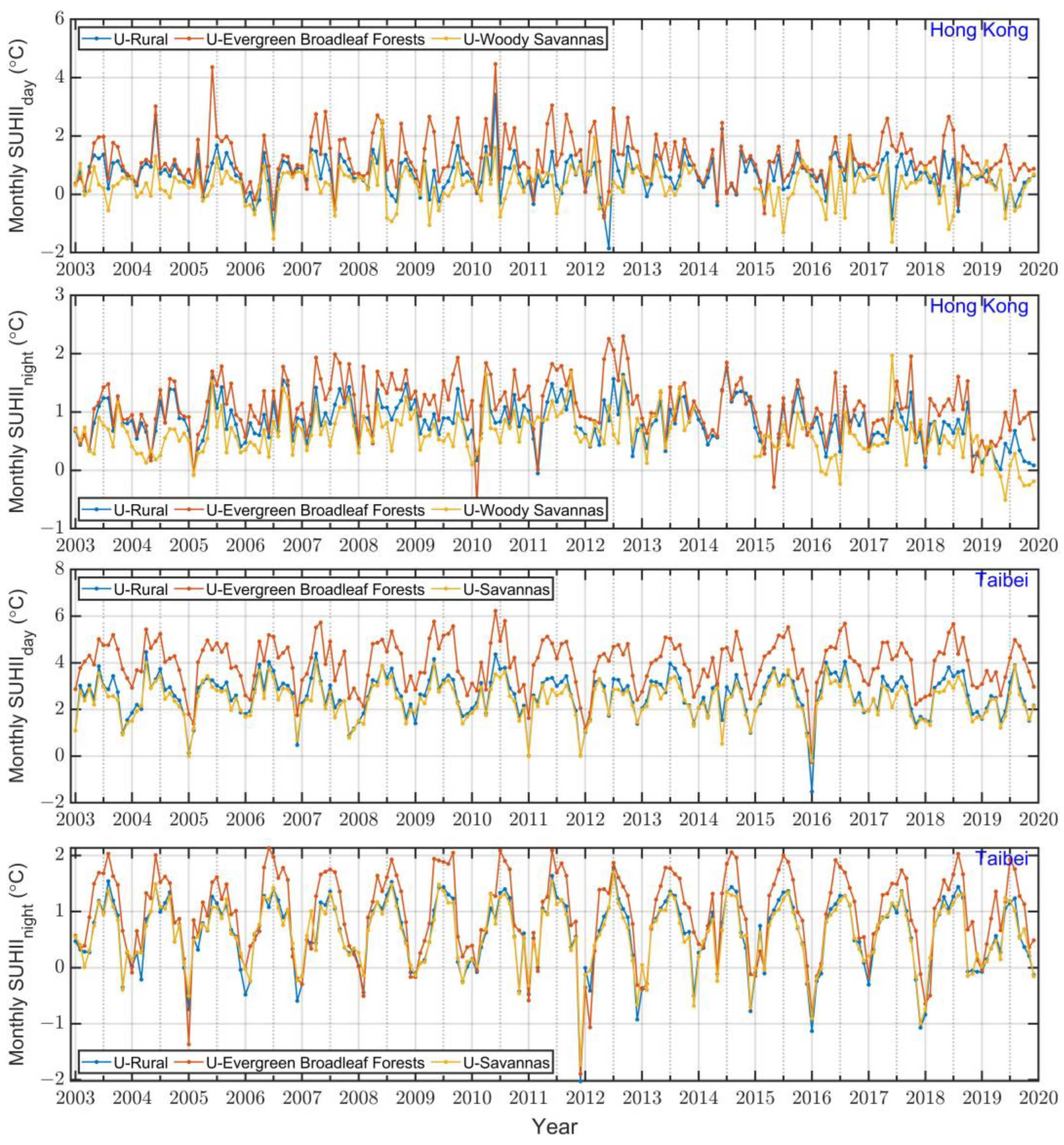

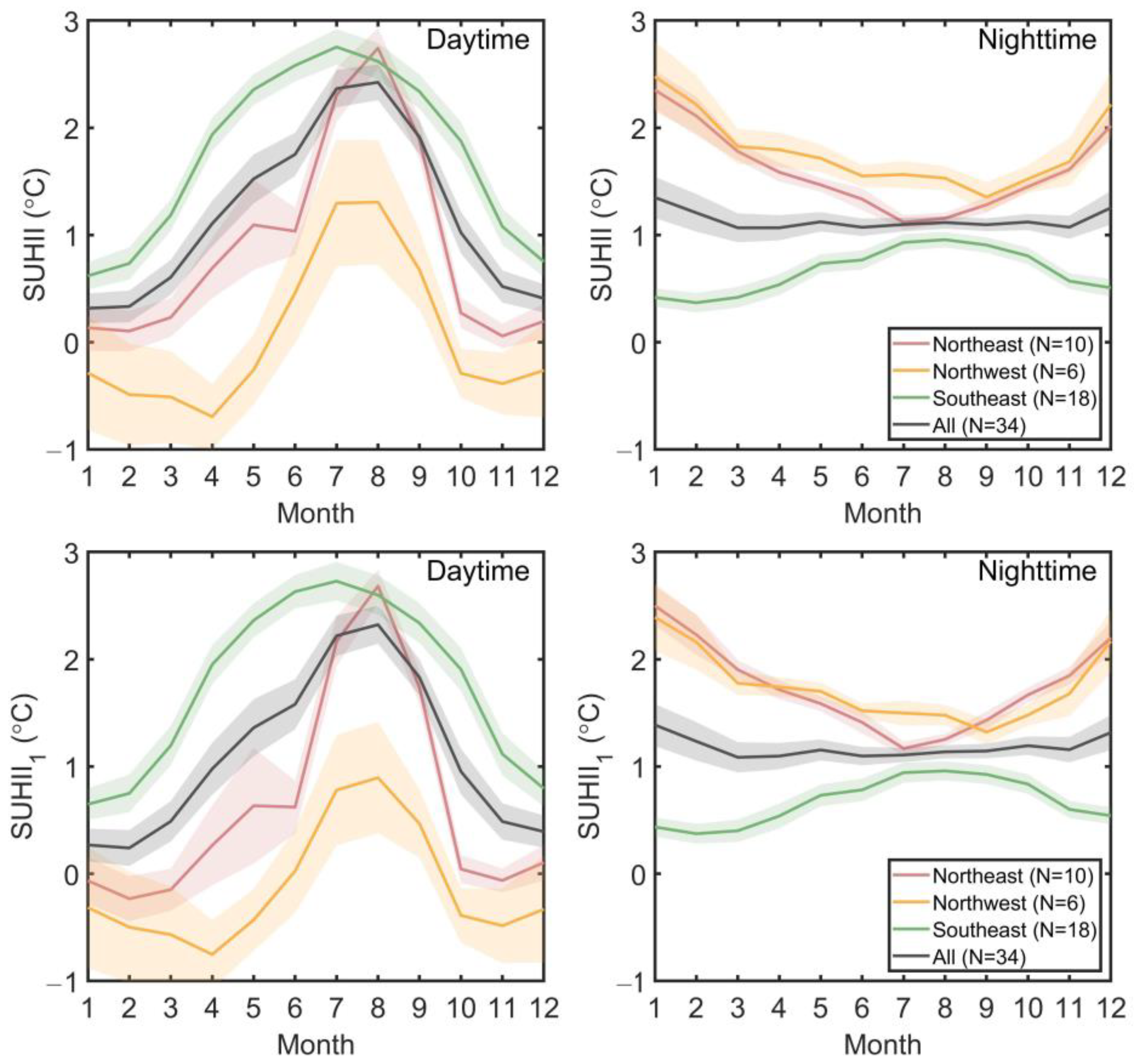
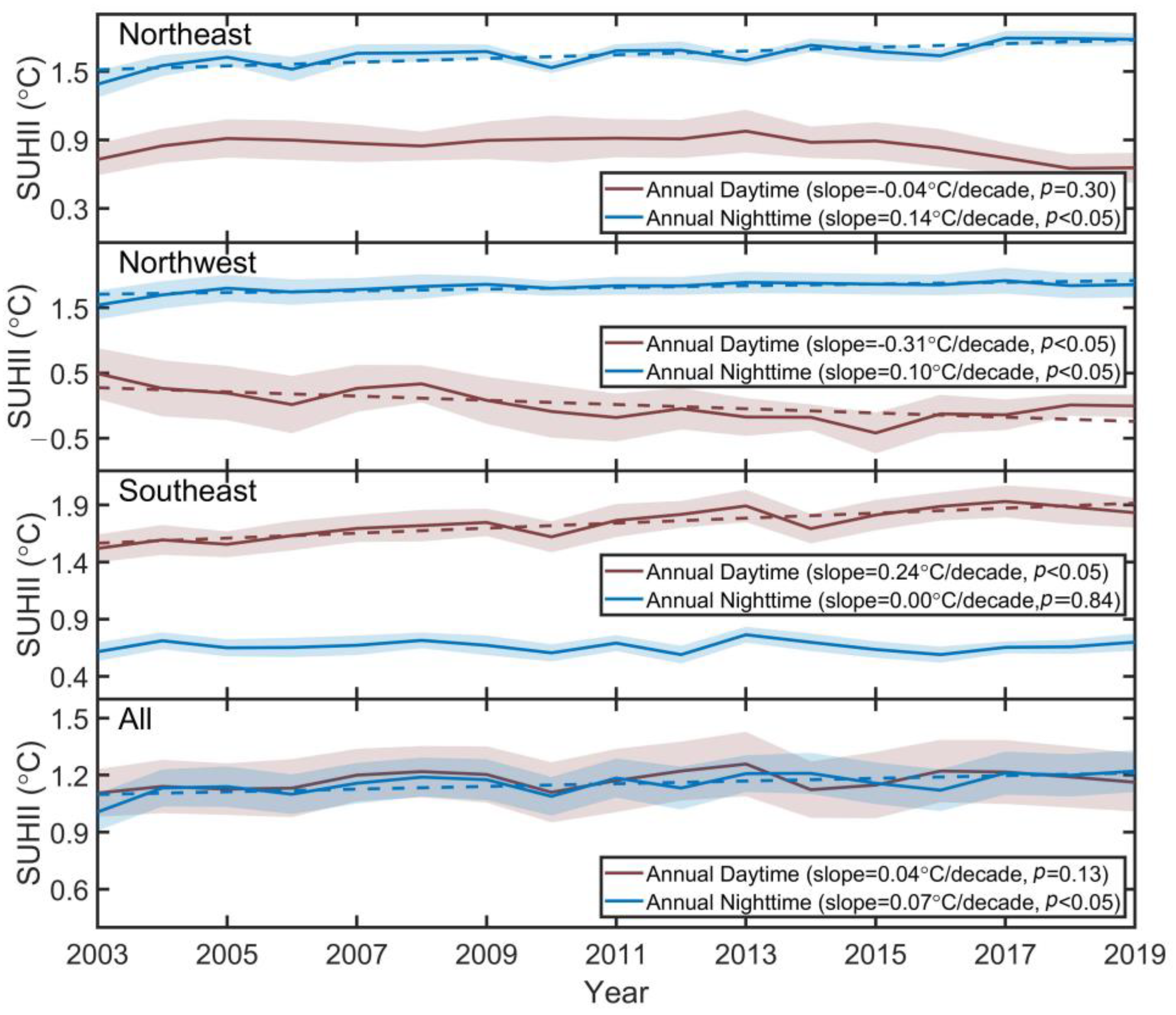


| Value | Name | Description |
|---|---|---|
| 1 | Evergreen Needleleaf Forests | Dominated by evergreen conifer trees (canopy > 2 m). Tree cover > 60%. |
| 2 | Evergreen Broadleaf Forests | Dominated by evergreen broadleaf and palmate trees (canopy > 2 m). Tree cover > 60%. |
| 3 | Deciduous Needleleaf Forests | Dominated by deciduous needleleaf (larch) trees (canopy > 2 m). Tree cover > 60%. |
| 4 | Deciduous Broadleaf Forests | Dominated by deciduous broadleaf trees (canopy > 2 m). Tree cover > 60%. |
| 5 | Mixed Forests | Dominated by neither deciduous nor evergreen (40–60% of each) tree type (canopy > 2 m). Tree cover > 60%. |
| 6 | Closed Shrublands | Dominated by neither deciduous nor evergreen (40–60% of each) tree type (canopy > 2 m). Tree cover > 60%. |
| 7 | Open Shrublands | Dominated by woody perennials (1–2 m height) 10–60% cover. |
| 8 | Woody Savannas | Tree cover 30–60% (canopy > 2 m). |
| 9 | Savannas | Tree cover 10–30% (canopy > 2 m). |
| 10 | Grasslands | Dominated by herbaceous annuals (<2 m). |
| 11 | Permanent Wetlands | Permanently inundated lands with 30–60% water cover and >10% vegetated cover. |
| 12 | Croplands | At least 60% of the area is cultivated cropland. |
| 13 | Urban and Built-up Lands | At least 30% impervious surface area, including building materials, asphalt, and vehicles. |
| 14 | Cropland/Natural Vegetation Mosaics | Mosaics of small-scale cultivation 40–60% with natural tree, shrub, or herbaceous vegetation. |
| 15 | Permanent Snow and Ice | At least 60% of the area is covered by snow and ice for at least 10 months of the year. |
| 16 | Barren | At least 60% of the area is non-vegetated barren (sand, rock, soil) areas with less than 10% vegetation. |
| 17 | Water Bodies | At least 60% of the area is covered by permanent water bodies. |
Disclaimer/Publisher’s Note: The statements, opinions and data contained in all publications are solely those of the individual author(s) and contributor(s) and not of MDPI and/or the editor(s). MDPI and/or the editor(s) disclaim responsibility for any injury to people or property resulting from any ideas, methods, instructions or products referred to in the content. |
© 2024 by the authors. Licensee MDPI, Basel, Switzerland. This article is an open access article distributed under the terms and conditions of the Creative Commons Attribution (CC BY) license (https://creativecommons.org/licenses/by/4.0/).
Share and Cite
Si, M.; Yao, N.; Li, Z.-L.; Liu, X.; Tang, B.-H.; Nerry, F. Feasibility of Urban–Rural Temperature Difference Method in Surface Urban Heat Island Analysis under Non-Uniform Rural Landcover: A Case Study in 34 Major Urban Agglomerations in China. Remote Sens. 2024, 16, 1232. https://doi.org/10.3390/rs16071232
Si M, Yao N, Li Z-L, Liu X, Tang B-H, Nerry F. Feasibility of Urban–Rural Temperature Difference Method in Surface Urban Heat Island Analysis under Non-Uniform Rural Landcover: A Case Study in 34 Major Urban Agglomerations in China. Remote Sensing. 2024; 16(7):1232. https://doi.org/10.3390/rs16071232
Chicago/Turabian StyleSi, Menglin, Na Yao, Zhao-Liang Li, Xiangyang Liu, Bo-Hui Tang, and Françoise Nerry. 2024. "Feasibility of Urban–Rural Temperature Difference Method in Surface Urban Heat Island Analysis under Non-Uniform Rural Landcover: A Case Study in 34 Major Urban Agglomerations in China" Remote Sensing 16, no. 7: 1232. https://doi.org/10.3390/rs16071232
APA StyleSi, M., Yao, N., Li, Z.-L., Liu, X., Tang, B.-H., & Nerry, F. (2024). Feasibility of Urban–Rural Temperature Difference Method in Surface Urban Heat Island Analysis under Non-Uniform Rural Landcover: A Case Study in 34 Major Urban Agglomerations in China. Remote Sensing, 16(7), 1232. https://doi.org/10.3390/rs16071232







